Hanging baskets can be more of a challenge to water than other pots because of their increased exposure to wind, and the limited quantity of potting soil, which is limited to keep the weight reasonable. Here is how to judge when and how to water your hanging basket plants.
Outdoor hanging baskets need to be watered typically one time a day. Twice a day for hanging baskets less than 12” in diameter and for baskets after the plants have grown to their full extent. This is typical during the hottest months and after 2 months of growth. This can be extended by using specialized reservoir pots or water-holding crystals.
There are many ways to reduce the watering needs of your pots, I am sure one of them will be just right for you!
- Water-saving crystals. These can be mixed into your potting soil at planting and do a great job of extending the even moisture level in your hanging baskets’ potting soil. These crystals expand when exposed to water and slowly release it as your potting soils need it, like having a water reservoir in bits throughout your soil! Soil Vigor is a great one, check it out by clicking here.
- Additive water reservoir. This adds a water reservoir after the plants are planted, and a good choice for hanging baskets purchased from the nursery. These are beautiful too! Great tip, if the plant you are adding these to a hanging basket that is fully rooted in, and the roots are dense, take a drill or an awl and pre-make a well-channel to make it easy to insert the stem! You will thank yourself later!
- Drought-resistant plants. If you live in an environment that is challenging for many plants (hot, dry, and low humidity for instance), drought-resistant plants will be great for you! Planting these will really lower your watering duties simply by their water-sipping tendencies. When you are looking for drought-resistant plants for your hanging baskets, you need to choose plants that are drought resistant because they are very efficient with water, not because they have such an extensive root system they find deep water. Those plants will hog all the water from your other plants, and the roots actually end up pushing the water-holding soil out of the pots, replacing it with all roots. Like lantana for instance. Great in the ground, but not in a pot.
My favorites are:
- Portulaca or moss rose
- Blue My Mind, an Evolvus hybrid
- Euphorbia, like Diamond Frost
- Bougainvillea
- Mandevilla
- Sedum
- Ivy-lead geranium, Pelargonium peltatum (not a zonal geranium)
- Tricolored sage, Salvia officinalis ‘Tricolor’
- Dusty miller, Centaurea cineraria
- Licorice plant

Portulaca 
Blue My Mind 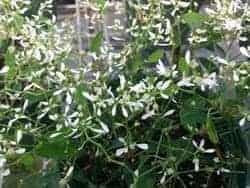
Euphorbia 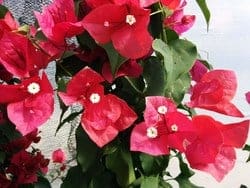
Bougainvillea 
Mandevilla 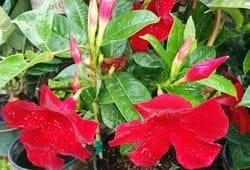
Mandevilla 
Various sedum 
Ivy Geranium 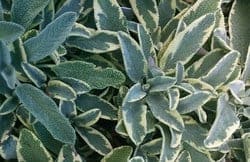
Tri-Color sage 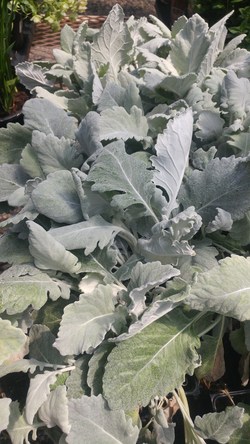
Dusty Miler 
Portulaca 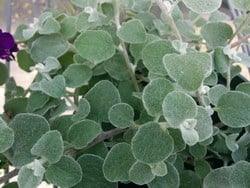
Licorice plant
Click Here to pick the Best Plants For You, every time!
- Self-watering pots. These pots have a water reservoir built right into the pot, so you can fill up the reservoir and let it slowly wick water up to your plants for an extended time. How long depends on the size of the reservoir…and every other factor I listed below in “Why do My Hanging Baskets Die”. Get as large of a hanging basket as you can and test how often a refill is needed for the reservoir, in your situation (how much sun, type plants, wind….). A rhythm will show itself so you count on when re-filling will be needed. Click below to see a post covering my favorite self-watering pots & containers.

- Automatic watering systems. This is for true worry-free watering for your pots, containers, and hanging baskets. Just like the irrigation systems for garden centers, nurseries, and farms, they are reliable and time-proven. However, they can be costly. Check out some of the best in this post –

Related Questions:
Can I overwater my hanging baskets?
Yes, however overwatering your hanging baskets is not common except in the spring when the plants are small and the weather cooler. You need to carefully check hanging baskets before watering to see if it is needed, especially while the amount of water holding capacity of the potting soil is greater than the plants need for a day.
A great way to do this is by weight. As soon as you thoroughly water your hanging basket, so the soil can not hold any more water, lift (while on hanging hook, just push up from the bottom just enough to lift it and feel the weight. Do not add more water until when you lift it up, it feels much lighter than expected. If you misjudge and wait too long, the soil will dry enough to pull away from the sides of the basket and allow the water to rush down and out before re-wetting the soil. Do not worry, simply take the basket down from where it is hanging and set it in water, a bucket, sink, kiddie pool…) for up to 2 hours to reset the potting soil, and know that you have learned to lowest weight your basket can be.
Overwatering plants come from watering too often rather than too much volume of water. If the pots do not have drainage holes, then overwatering is likely. The potting soil can be saturated partway down into the pot and have root rot set in, while the potting soil at the surface can appear to be ready for more water.
Why Do My Hanging Baskets Die?
The most common cause of hanging basket plant death is overwatering in the spring, underwatering in the summer, and fall or frost in the fall. The one thing you must do to prevent most hanging basket death is to check the SOIL before watering for how much water it is holding BEFORE watering. You can check with a moisture meter9you can get a reliable, affordable one here) ,https://amzn.to/38uZ4Ou?tag=besidethefr04-20 with your finger, pushed into the second knuckle,(if you feel moisture, wait before watering), or by weight. To check by weight, in my opinion, the fastest and most accurate method that we use in the industry, then as soon as you thoroughly water your hanging basket, so the soil can not hold any more water, lift (while on hanging hook, just push up from the bottom just enough to lift it and feel the weight. Do not add more water until when you lift it up, it feels much lighter than expected. If you misjudge and wait too long, the soil will dry enough to pull away from the sides of the basket and allow the water to rush down and out before re-wetting the soil. Do not worry, simply take the basket down from where it is hanging and set it in water, a bucket, sink, kiddie pool…) for up to 2 hours to reset the potting soil, and know that you have learned to lowest weight your basket can be.
Watering planters, including hanging baskets, is not like following a recipe, where you use exactly so much water for such and such size pot. It is a balance that is drastically affected by the humidity, components of the potting soil, types of plants, wind, temperature, size of plants in relation to the amount of soil to name a few. Think of it similarly to deciding what to wear in the morning. You can not know simply by the date on the calendar, but you check the weather forecast for the temperature, if it will rain, wind, what you plan to do for activities (work, office, job interview, beach, hiking..)that day and more…
At What Temperature Should I Bring My Hanging Baskets Inside?
If the forecast is for anything below 40 deg F (4 deg C), bring your hanging baskets with frost-sensitive plants inside for the night. A frost happens when the air temperature dips to 32 F or 0 Celcius. The raised position of hanging baskets makes them more vulnerable to frosts than plants in the ground, as well as microclimate conditions at your exact spot means to be safe, bring them in at 40 deg F (4 deg C).
References:
Effect Of Polymer On Soil Water Holding Capacity And Plant Water Use Efficiency | QUT ePrints
Sivapalan, Siva (2001) Effect Of Polymer On Soil Water Holding Capacity And Plant Water Use Efficiency. In 10th Australian Agronomy Conference 2001. The Regional Institute, Australia, -.
https://doi.org/10.2478/v10104-009-0005-0

